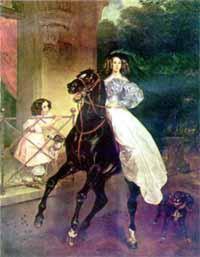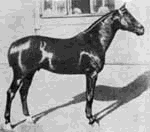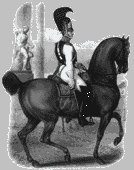|
|
| The
Orlov-Rostopchin (Russian Riding horse)
Black of exotic
beauty and substance
for dressage and pleasure. Now quite rare.
|
 |
The Orlov-Rostopchin is an exotic horse.
Everything about it is unusual and romantic: its appearance, its origin, its
fate. To begin with, it is a product of an exciting competition and a
brainchild of two aristocratic breeding talents, Count Orlov and Count
Rostopchin.
The two counts followed the same breeding
philosophies. And no wonder that when after their deaths their studs were
bought by the Crown, the Orlovs and Rostopchins were merged to give rise to
Orlov-Rostopchins. The Orlov-Rostopchin combines the size, type and dressage
abilities of the Orlovs and the speed of the Rostopchins.
In those days Russian breeding was dominated by the teachings of the French
naturalist Buffon. Buffon maintained that crossing was the surest way to
“reproduce the prototype” of a given animal species from “bits
of perfection, which have been dispersed by God among individual breeds”
and which through crossing and mixture “...combine to yield the supreme
beauty.” All Russian breeders of the time went overboard in order to
“reproduce the prototype,” with nil results, of course.
 |
Orlov and Rostopchin were
not Buffon’s disciples, they went their own ways, using their own methods
of crossing, selection, and culling. They also had their own ways of training
the young, and testing the performance of their horses. |
Orlovs Legend has it that an idea to produce superb Russian horses first
occurred to the Orlov brothers, when they, favorites of Catherine the Second,
were meeting her on a road when she was dashing from Peterhof to St-Petersburg
to head her coup de t’etat against her husband Peter III. But en
route, of all the moments, her coach came to a grinding halt, because her fancy
European horses couldn’t stand the pace. The officers rushed to a nearest
bawdy tavern, borrowed a set of hardy but unattractive nags and harnessed them
onto the imperial coach to haul Catherine to her destination. Catherine’s
and the Orlov’s lives hung on a thread.
This unglamorous episode put one of the brothers, Alexey, in mind of producing
some time a Superb Horse. And so, when retired, Alexey Orlov got round to it,
breeding in parallel a Superb Trotter and a Superb Mount. And both of his
undertakings were a huge success.
Orlov mounts were the first saddle breed developed in Russia with method and
perseverance. In the latter half of the 18th century, in the era of
Russo-Turkish wars, Orlov brought to Russia a large number of Arabians, among
them the silvery gray Smetanka, and the brown Sultan I, Arabian stallions of
outstanding distinction. Both of them were used by Orlov during one season only
and fell to leave two daughters and six sons, among them Felkerzam I and Sultan
II, the stock stallions of the breed.
In addition to Arabians, Orlov used Thoroughbred, Karabakh, Turkish, and even
Danish horses. As to Thoroughbreds, the breeder only used Russian-bred unraced
mares.
Later on the desired type was reinforced by moderate inbreeding. A good example
is the pedigree of the bay Yashma II, f. 1833, one of the best sires at
Khrenovoye and the founder of a line. One sees in it several occurrences of
Felkerzam I and Saltan II.
This pedigree gives a clear insight into Orlov’s approach to
breeding:
| Yashma II foaled 1833
|
 |
Yashma I,
1816 |
Ashonok |
Svirepy II (Grafski) |
Saltan
II |
Saltan I x
Gullivaya |
| Uyutnaya |
Milyj x
Uyutnaya |
| Dosuzhaya |
Ah I |
Akut x
Svirepaya |
| Kartinka |
Felkerzam I x (?)
|
| Yashnaya |
A white stallion |
![zero.gif (44 bytes)]() |
![zero.gif (44 bytes)]() |
![zero.gif (44 bytes)]() |
![zero.gif (44 bytes)]() |
| Yashnaya |
Felkerzam
II |
Felkerzam I x
Izmenshitsa |
| Neizmennaya |
Saltan II x TB
mare |
|
Venera,
1821
|
Vazhny II |
Vazhny I |
Svirepyi I |
Saltan II x Uyutnaya |
| Izomnaya |
Felkerzam I x Khripunya |
| Naneta |
Tendem |
![zero.gif (44 bytes)]() |
| Yashnaya |
Arap II x Livarka |
| Sibirskaya |
Postoyanny |
Postoyanny I |
Saltan II x Bay mare |
| Ubornaya |
Dobrovolny x Bay mare |
| Milovidnaya |
Felkerzam I |
Smetanka x TB mare |
| Golubaya |
Borodovkin x TB Mare |
The incarnation of Orlov’s idea of the
saddle horse was the bay Svirepy II (Saltan II x Uyutnaya). With his perfect
conformation, a height of 158 cm and his ability for dressage he became the
favorite mount of the Count, who rode him all his life.
Of immense importance for the creation of the breed were the ideal steppe
conditions at Khrenovoye and carefully hand-picked foundation stock of various
breeds, especially the outstanding Arabian individuals used by Count Orlov at
the beginning.
Several decades of hard work yielded an
outstanding creature. Orlovs were elegant and strikingly beautiful. Those black
horses had an exquisite dished head, large expressive eyes, a swan-like neck,
an excellent poll, and a superb topline. Their legs were strong, clean, and
correctly placed.
Their size, athletic qualities and kind disposition made them unparalleled
mounts for cavalry. Russia thus obtained an excellent saddle horse, which
surpassed in many respects most European breeds of the day.
According to the 1866 Statement of the Russian Directorate of Horse Breeding
nearly a half of stallions used at breeding stations in the country were
Orlovs.
Rostopchins
Count Rostopchin did not have the huge
resources of Alexey Orlov’s, but he was his match in perseverance and
ambitions. And his achievements were nearly as impressive. Just like Orlov, he
relied on Arabian blood. In 1802 he bought in Arabia the stallions Rishan,
Kaimak, and Kadi and used them on Thoroughbred, Persian, Karabakh, and Don
mares to create the horse that came to be known as the Rostopchin. The young
thus produced were subjected to the most rigorous culling for conformation and
speed, mostly for speed.
 |
Nearly all the horses
were trained and tested. And Rostopchin’s mounts were remarkably
successful on the race track: his gray stallion Anubus, f. 1824, was an
invincible runner and defeated even Thoroughbreds brought from England.
Unlike the Orlovs, the Rostopchin horses were not so exotically typey, they
were smaller, had a shorter neck and poll.
And they were black as well. |
Orlov-Rostopchins
In 1842 Orlov’s Khrenovoye stud and
Rostopchin’s Annenkov stud were bought by the Crown. The horses and the
breeding programs were merged to give rise to the Orlov-Rostopchin horse. In
1883 the Orlov-Rostopchin horses were transferred to the Limarevo State stud.
The stud’s brief was to produce superb officer horses with excellent
conformation and endurance. And the stud met whose requirements. To work out
robust constitution and sound health the horses at the stud were kept mostly
outdoors and subjected to rigorous tests.
The type and beauty of Orlov-Rostopchins caught the fancy of the Russian
breeders and the horses were in great demand as improvers of Russian breeds,
specifically Don and Strelets horses. Also Orlov-Rostopchin stallions were
heavily used on steppe horses in eastern Russia.
Exhibition awards
Orlov-Rostopchin horses were always an
attraction at any Russian and international exhibition and fair. They bagged
dozens of awards. Some examples:
| 1867 |
Stallions Frant,
Fakel, and Fazan receive a Gold Medal at the Paris
Exhibition |
| 1893 |
Priyatel,
Yashma’s son, is recognized the best saddle horse at the World
Exhibition at Chicago, and sold for the then unheard-of sum of 10,000
roubles |
| 1896 |
Priezd,
Yashma-Priyatny’s son, is awarded the Grand Prix at the Chicago
Exhibition; Predvoditel, another Yashma-Priyatny’s son, receives the
Great Gold Medal at Nizny Novgorod |
| 1898 |
Stallion Bayanchik
receives the Great Gold Medal at the St-Petersburg
exhibition |
| 1890 |
Stallion Bayanchik
receives a Gold Medal; and Yashma-Priyatny, the Great Silver
Medal in Paris |
| 1907 |
Vorobei receives the
Great Gold Medal at a Rostov-on-Don exhibition |
| 1912 |
Vorobei receives the
First Prize at the London Exhibition |
| 1913 |
Mare Zurna receives a
Gold Medal at Kie |
Restoration of the breed
During the two world wars most of
Orlov-Rostopchin horses were lost. What little has remained of the once famous
breed has been concentrated at several studs. The breed is being restored. It
is now officially referred to as the Russian Saddle horse.
It is still going to take much time and hard work for Russian studs to build up
enough stock and to produce those remarkable horses in quantity.
Average measurements of modern
Orlov-Rostopchins
|
Stallions |
Mares |
| Height |
163 |
161 |
| Body
length |
165 |
164 |
| Chest
girth |
184 |
183 |
| Bone below the
knee |
20.5 |
20 |
Colors The predominant color of Orlov-Rostopchins is black; there are also
browns and bays.
Temperament disposition
The Orlov-Rostopchin is a versatile and willing
worker. He has a quiet temperament and is quite trainable. This all makes these
horses good for dressage.
Dressage potential
Orlov-Rostopchins are favored by dressage
riders. Barin and Dixon took part in Olympic Games.
A limited number of
Orlov-Rostopchins are available for sale.
Some Orlov-Rostopchins have already been sold to the States and other
countries.
 |
All the information and
photographs for this section were kindly provided by Troika, the ultimate
Russian horse resource online. For further information on Russian horses and
horsemanship please click
here |
|

